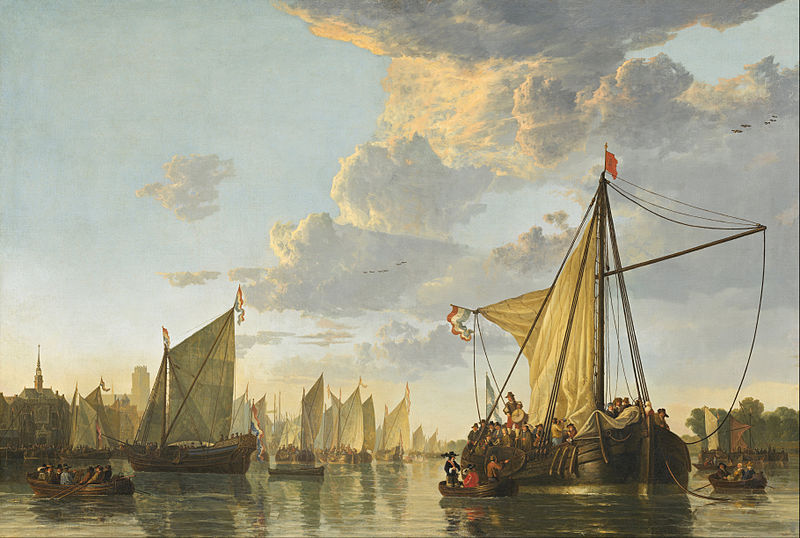| 作品の来歴 |
Johan van der Linden van Slingeland [1701 1782], Dordrecht, by 1752.[1] (his estate sale, at his residence by J. Yver and A. Delfos, Dordrecht, 22 August 1785 and days following, no. 70); "Rens" or "Delfos."[2] (Alexis Delahante, London), c. 1804 to 1814; sold to Abraham Hume, Bart. [1749 1838], Wormley, Hertfordshire, by 1815;[3] by inheritance to his grandson, John Hume Cust, Viscount Alford, M. P. [1812 1851], Ashridge Park, Hertfordshire; by inheritance to his son, John William Spencer, 2nd earl Brownlow [1842 1867], Ashridge Park; by inheritance to his brother, Adelbert Wellington, 3rd earl Brownlow [1844 1921], Ashridge Park and London; (his estate sale, Christie, Manson & Woods London, 4 and 7 May 1923, no. 75); (Duveen Brothers, Inc., London, New York, and Paris);[4] by exchange 1940 to The A.W. Mellon Educational and Charitable Trust, Pittsburgh; gift 1940 to NGA.
[1] Gerard Hoet, Catalogus of Naamlyst van Schilderijen..., 2 vols., The Hague, 1752, 2: 490. Van Slingeland's inventory describes two paintings as: "Two pieces, being the view of the City of Dordrecht to the Huys Merwede with many yachts and ships, being a rendezvous there [of] Prince Maurits of Orange in a 'Chaloup' with several other Princes of the city brought over to the yacht along which 'Chaloup' is another in which Oldenbarnevelt stands to see Prince Maurits, from life, by Aelbert Cuyp. each h. 43 d. w. 64 1/2 d." ["Twee stukken, zynde het Gezigt van de Stad Dordrecht tot het huys Merwerde met veele Jachten en Scheepen, zynde een Rendevous daar Prins Maurits van Orange in een Chaloup met eenige andere Prince van de Stad na het jagt wert gevoert tegens over welke Chaloup een andere is waarinne Oldenbarnevelt overend staande op Prince Maurits siet, na het Leven, door Albert Kuyp. ieder h. 43 d. br. 64 en een half d."] The description and dimensions seem to identify these paintings as Cuyp's View on the Maas near Dordrecht at Waddesdon Manor and the Gallery's The Maas at Dordrecht. As Oldenbarnevelt was executed in 1619 and Prince Maurits had died in 1625, these identifications were clearly fanciful.
[2] A margin note in the NGA copy of the sale catalogue gives the buyer as Delfos (who was one of the auctioneers and also bought several other paintings in the sale), but a note in a copy at the British Museum Library gives the buyer as "Rens." Cornelis Hofstede de Groot, A Catalogue Raisonné of the Works of the Most Eminent Dutch Painters of the Seventeenth Century..., 8 vols., trans. from the German edition, London, 1907 1927, 2: 17 18, no. 36, says lot 70, which he mistakenly believed to be the Waddesdon Manor painting (Stephen Reiss, Aelbert Cuyp, Boston, 1975: 145, no. 106), was sold to "Reus," and although the note in the copy of the catalogue in the Rijksbureau voor Kunsthistorisches Documentatie could be read as either "Reus" or "Rens," the one in the British Museum Library is not ambiguous.
[3] William Buchanan, Memoirs of Painting, 2 vols., London, 1824: 2:192. The dates for Delahante's ownership are from the Duveen prospectus for the painting, in NGA curatorial files. Hume lent the painting to an exhibition in 1815.
[4] Details about Duveen’s ownership of the painting (it was their inventory number 4870) can be traced in the Duveen Brothers Records, accession number 960015, Research Library, Getty Research Institute, Los Angeles: reel 36, box 108, page from the Paris stockbook for May 1923; reel 45, box 133, folder 5; reel 66, box 186, page from the general stockbook where the painting is number 28069; reel 89, box 234, folder 18; reel 189, box 334, folder 2, correspondence about the "loan" of the painting to the Kaiser Friedrich Museum in 1931 and the possibility of it being exchanged for a work in the Berlin museum's collection.
|









